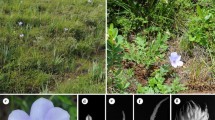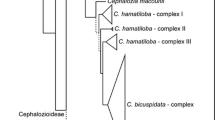Abstract
A hypothesis of phylogenetic relationships inferred from analysis of plastid-encoded rbcL sequences is presented for members of the Solieriaceae, an economically important family containing carrageenan-type phycocolloids. Previous studies established that the Solieriaceae sensu lato forms a terminal clade in the Solieriaceae complex, a cluster of families sister to the Gigartinaceae complex (Gigartinaceae and Phyllophoraceae). The family Solieriaceae (including the Areschougiaceae) presently contains about 20 genera that are widely distributed in warm-temperate and tropical waters throughout the world. Molecular rbcL and published morphological evidence are consistent with an Australasian origin for the family and a Tethyan distribution for its tropical representatives from west to east as far as the Pacific coast of North and South America. The austral lineages (Callophycus, Rhabdonia, Areschougia and Erythroclonium) are resolved at the base of the tree. The remaining genera , comprising the tropical and subtropical cluster, form a robust terminal clade (100% bootstrap support). This assemblage can be divided into seven groups, most of which receive strong bootstrap support: (1) Sarconema, (2) a Eucheuma group, (3) an Atlantic Solieria group, (4) an Indo-Pacific Solieria robusta group, (5) a Meristiella/Meristotheca group, (6) Agardhiella and (7) a Sarcodiotheca group that includes 'Eucheuma' uncinatum from the Gulf of California. Four clusters of species are recognized in the Eucheuma group that correspond to the sections: Eucheuma, Gelatiformia (= Betaphycus), Anaxiferae, and Cottoniformia (= Kappaphycus) proposed by Maxwell Doty. No decision is reached regarding the taxonomic rank appropriate to the eucheumoid taxa.
Similar content being viewed by others
References
Agardh, J. G., 1842. Algae maris Mediterranei et Adriatici. Fortin, Masson et Cie, Paris, x + 164 pp.
Agardh, J. G., 1876. Species genera et ordines algarum, 3(1) Epicrisis systematis Floridearum. T.O.Weigel, Leipzig, vii + 724 pp.
Benson, D. A., M. Boguski, D. J. Lipman & J. Ostell, 1994. Genbank. Nucleic Acids Res. 22: 3441–3444.
Bush, A. B. G., 1997. Numerical simulation of the Cretaceous Tethys circumglobal current. Science. 275: 807–810.
Chiovitti, A., M.-L. Liao, G. T. Kraft, S. L. A. Munro, D. J. Craik & A. Bacic, 1995. Cell wall polysaccharides from Australian red algae of the family Solieriaceae (Gigartinales, Rhodophyta): iota/kappa/beta-carrageenans from Melanema dumosum. Phycologia 34: 522–527.
Chiovitti, A., M.-L. Liao, G. T. Kraft, S. L. A. Munro, D. J Craik & A. Bacic, 1996. Cell wall polysaccharides from Australian red algae of the family Solieriaceae (Gigartinales, Rhodophyta): highly methylated carrageenans from the genus Rhabdonia. Bot. mar. 39: 47–59.
Chiovitti, A., A. Bacic, D. J. Craik, S. L. A. Munro, G. T. Kraft & M.-L. Liao, 1997a. Carrageenans with complex substitution patterns from red algae of the genus Erythroclonium. Carbohydr. Res. 305: 243–252.
Chiovitti, A., A. Bacic, D. J. Craik, S. L. A. Munro, G. T. Kraft & M.-L. Liao, 1997b. Cell-wall polysaccharides from Australian red algae of the family Solieriaceae (Gigartinales, Rhodophyta): novel, highly pyruvated carrageenans from the genus Callophycus. Carbohydr. Res. 299: 229–243.
Chiovitti, A., G. T. Kraft, A. Bacic, D. J. Craik, S. L. A. Munro & M.-L. Liao, 1998. Carrageenans from Australian representatives of the family Cystocloniaceae (Gigartinales, Rhodophyta), with description of Calliblepharis celatosporasp. nov., and transfer of Austrocloniumto the family Areschougiaceae. J. Phycol. 34: 515–535.
Collins, F. S. & A. B. Hervey, 1917. The algae of Bermuda. Proc. am. Acad. Arts Sci. 53: 1–195.
Doty, M. S., 1985. Eucheuma alvareziisp. nov. (Gigartinales, Rhodophyta) from Malaysia. In Abbott, I. A. & J. N. Norris (eds), Taxonomy of Economic Seaweeds with Reference to Some Pacific and Caribbean Species. La Jolla: California Sea Grant College Program [Report T-CSGCP-011]: 37–45.
Doty, M. S., 1988. Prodromus ad systematica Eucheumatoideorum: a tribe of commercial seaweeds related to Eucheuma(Solieriaceae, Gigartinales). In Abbott, I. A. (ed.), Taxonomy of Economic Seaweeds With Reference to Some Pacific and Caribbean Species. La Jolla: California Sea Grant College Program [Report T-CSGCP-018] 2: 159–207.
Doty, M. S., 1995. Betaphycus philippinensisgen. et sp. nov. and related species (Solieriaceae, Gigartinales). In Abbott, I. A. (ed.), Taxonomy of Economic Seaweeds With Reference to Some Pacific Species. La Jolla: California Sea Grant College Program [Report T-CSGCP-035] 5: 237–245.
Doty, M. S. & J. N. Norris, 1985. Eucheumaspecies (Solieriaceae, Rhodophyta) that are major sources of carrageenan. In Abbott, I. A. & J. N. Norris (eds), Taxonomy of Economic Seaweeds With Reference to Some Pacific and Caribbean Species. La Jolla: California Sea Grant College Program [Report T-CSGCP-011]: 47–61.
Farnham, W. F., 1980. Studies on aliens in the marine flora of southern England. In Price, J. H., D. E. G. Irvine & W. F. Farnham (eds), The Shore Environment, vol. 2. Ecosystems. Academic Press, London: 875–914.
Farris, J. S., 1989. The retention index and the rescaled consistency index. Cladistics 5: 417–419.
Felsenstein, J., 1981. Evolutionary trees from DNA sequences: A maximum likelihood approach. J. mol. Evol. 17: 368–376.
Felsenstein, J., 1985. Confidence limits on phylogenies: an approach using the bootstrap. Evolution 39: 783–791.
Fredericq, S. & M. E. Ramírez, 1996. Systematic studies of the antarctic species of the Phyllophoraceae (Gigartinales, Rhodophyta) based on rbcL sequence analysis. Hydrobiologia 326/327: 137–143.
Fredericq, S., M. H. Hommersand & D. W. Freshwater, 1996. The molecular systematics of some agar-and carrageenan-containing marine red algae based on rbcL sequence analysis. Hydrobiologia 326/327: 125–135.
Freshwater, D. W. & J. Rueness, 1994. Phylogenetic relationships of some European Gelidium(Gelidiales, Rhodophyta) species, based on rbcL nucleotide sequence analysis. Phycologia 33: 187–194.
Freshwater, D.W., S. Fredericq, B. S. Butler, M. H. Hommersand & M. W. Chase, 1994. A gene phylogeny of the red algae (Rhodophyta) based on plastid rbcL. Proc. natn. Acad. Sci. U.S.A. 91: 7281–7285.
Gabrielson, P. W., 1982a. Morphological studies of members of the tribe Agardhielleae, (Solieriaceae, Rhodophyta) I. Sarcodiotheca furcataPhycologia 21: 75–85.
Gabrielson, P. W., 1982b. Morphological studies of members of the tribe Agardhielleae (Solieriaceae, Rhodophyta) II. Sarcodiotheca gaudichaudii(Montagne) comb. nov. Phycologia 21: 86–96.
Gabrielson, P.W., 1983. Vegetative and reproductive morphology of Eucheuma isiforme(Solieriaceae, Gigartinales, Rhodophyta). J. Phycol. 19: 45–52
Gabrielson, P. W., 1985. Agardhiellaversus Neoagardhiella(Solieriaceae, Rhodophyta) another look at the lectotypification of xGigartina tenera. Taxon 34: 275–280.
Gabrielson, P.W. & D. P. Cheney, 1987. Morphology and taxonomy of Meristiellagen. nov. (Solieriaceae, Rhodophyta). J. Phycol. 23: 481–493.
Gabrielson, P. W. & M. H. Hommersand, 1982a. The Atlantic species of Solieria(Gigartinales, Rhodophyta); their morphology. distribution and affinities. J. Phycol. 18: 31–45.
Gabrielson, P. W. & M. H. Hommersand, 1982b. The morphology of Agardhiella subulatarepresenting the Agardhielleae, a new tribe in the Solieriaceae (Gigartinales, Rhodophyta). J. Phycol. 18: 46–58.
Gabrielson, P. W. & G. T. Kraft, 1984. The marine algae of Lord Howe Island (N.S.W.): the family Solieriaceae (Gigartinales, Rhodophyta). Brunonia 7: 217–251
Greer, C. W. & W. Yaphe, 1984. Characterisation of hybrid (betakappa-gamma) carrageenan from Eucheuma gelatinaeJ. Agardh (Rhodophyta, Solieriaceae) using carrageenases, infrared and 13C-nuclear magnetic resonance spectroscopy. Bot. mar. 27: 473–478.
Guimarães, S. M. P. B. & E. C. Oliveira, 1996. Taxonomy of the flattened Solieriaceae (Rhodophyta) in Brazil: Agardhiellaand Meristiella. J. Phycol. 32: 656–668
Hillis, D.M. & J. P. Huelsenbeck, 1992. Signal, noise and reliability in molecular phylogenetic analyses. J. Hered. 83: 189–195.
Hillis, D. M., M. W. Allard & M. M. Miyamoto, 1993. Analysis of DNA sequence data: phylogenetic inference. Methods Enzymol. 224: 456–487.
Hillis, D. M., B. K. Mable, A. Lason, S. K. Davis & E. A. Zimmer, 1996. Nucleic Acids IV: sequencing and cloning, pp. 321–381. In Hillis, D. M., C. Moritz & B. K. Mable (eds), Molecular Systematics. Sinauer Associates, Inc., Sunderland, MA, 655 pp.
Hommersand, M. H., 1986. The biogeography of the South African marine red algae: a model. Bot. mar. 29: 257–270.
Hommersand, M. H. & S. Fredericq, 1990. Sexual reproduction and cystocarp development. In Cole, K. M. & R. G. Sheath (eds), Biology of the Red Algae, Cambridge University Press, New York: 305–345.
Hommersand, M. H., S. Fredericq & D. W. Freshwater, 1994. Phylogenetic systematics and biogeography of the Gigartinaceae (Gigartinales, Rhodophyta) based on sequence analysis of rbcL. Bot. mar. 37: 193–203.
Kimura, M., 1980. A simple method for estimating evolutionary rates of base substitutions through comparative studies of nucleotide sequences. J. mol. Evol. 16: 111–120.
Kluge, A. G. & J. S. Farris, 1969. Quantitative phyletics and the evolution of anurans. Syst. Zool. 18: 1–32.
Kraft, G. T., 1984. Taxonomic and morphological studies of tropical and subtropical species of Callophycus(Solieriaceae, Rhodophyta). Phycologia 23: 53–71.
Kraft, G. T. & P. W. Gabrielson, 1983. Tikvahiella candidagen. et sp. nov. (Solieriaceae, Rhodophyta), an new adelphoparasite from southern Australia. Phycologia 22: 47–57.
Kützing, F. T., 1843. Phycologia generalis. F.A. Brockhaus, Leipzig. xxxii + 458 pp, 80 pls.
Kylin, H., 1932. Die Florideen ordnung Gigartinales. Lunds Univ. Årsskr., NF., Avd 2, 28(8): 88 pp.
Kylin, H., 1956. Die Gattungen der Rhodophyceen. Lund: C.W.K. Gleerups Förlag. xv + 673 pp., 458 figs.
Lawson, G. W. & D. M. John, 1987. The marine algae and coastal environment of tropical West Africa, 2nd edn. Beihefte zur Nova Hedwigia 93: 1–415.
Maddison, D. R., 1991. The discovery and importance of multiple islands of most-parsimonious trees. Syst. Zool. 40: 315–328.
Maddison. W. P. & D. R. Maddison, 1992. MacClade: Analysis of Phylogeny and Character Evolution. Sinauer Associates, Sunderland, MA, 398 pp.
Min-Thein, U. & H. B. S. Womersley, 1976. Studies on southern Australian taxa of Solieriaceae, Rhabdoniaceae and Rhodophyllidaceae (Rhodophyta). Aust. J. Bot. 24: 1–166.
Mshigeni, K. E. & G. F. Papenfuss, 1981. Solieria jaasundii, a new species of red algae (Gigartinales, Solieriaceae) from Tanzania. Bot. mar. 24: 1–7.
Norris, J. M., 1985. Observations on EucheumaJ. Agardh (Solieriaceae, Rhodophyta) from the Gulf of California, Mexico. In Abbott, I. A. & J. N. Norris (eds), Taxonomy of Economic Seaweeds With Reference to some Pacific and Caribbean Species. La Jolla: California Sea Grant College Program [Report T-CSGCP-011]: 63–65.
Papenfuss, G. F. & T. Edelstein, 1974. The morphology and taxonomy of the red alga Sarconema(Gigartinales: Solieriaceae). Phycologia 13: 31–44.
Perrone, C. & E. Cecere, 1994. Two solieriacean algae new to the Mediterranean: Agardhiella subulataand Solieria filiformis(Rhodophyta, Gigartinales). J. Phycol. 30: 98–108.
Rayss, T., 1963. Sur la présence dans la Méditeranée orientale des algues tropicales de la famille des Solieriacées. Acta Bot. Horti. Bucharest 1961/1962: 91–106.
Rueness, J., 1997. A culture study of Caulacanthus ustulatus(Caulacanthaceae, Gigartinales, Rhodophyta) from Europe and Asia. Cryptogamie Algol. 18: 175–185.
Saitou, N. & M. Nei, 1987. The neighbor-joining method: a new method for reconstructing phylogenetic trees. Mol. biol. Evol. 4: 406–425.
Santos, G. A., 1989. Carrageenans of species of EucheumaJ. Agardh and KappaphycusDoty (Solieriaceae, Rhodophyta). Aquat. Bot. 36: 55–67.
Searles, R. B., 1968. Morphological studies of red algae of the order Gigartinales. Univ. Calif. Publ. Bot. 43: 1–86.
Silva, P. C., 1980. Names of classes and families of living algae with special reference to their use in the Index Nominum Genericorum (Plantarum). Regnum Vegetabile 103. [iii +] 156 pp.
Silva, P. C., 1993. Report of the committee for algae: 1. Taxon 42: 699–710.
Silva, P. C., P. W. Basson & R. L. Moe, 1996. Catalogue of the benthic marine algae of the Indian Ocean. Univ. California Press, Berkeley, xiv + 1259 pp.
Swofford, D. L, 1998. PAUP*: Phylogenetic analysis using parsimony (and other methods). Version 4.0b.1. Sinauer Associates, Sunderland, MA.
Weber-van Bosse, A., 1928. Liste des algues du Siboga IV. Rhodophyceae. Pt. 3, Gigartinales et Rhodymeniales et tableau de la distribution des Chlorophycées, Phaeophycées et Rhodophycées de L'archipel Malaisien. Siboga-Expeditie Monographie 59. Leiden: 393–533, figs 143–213, pls. XI–XVI.
Womersley, H. B. S., 1994. The marine benthic flora of southern Australia. Rhodophyta: Part IIIA. Bangiophyceae and Florideophyceae (Acrochaetiales, Nemaliales, Gelidiales, Hildenbrandiales and Gigartinales sensu lato). Canberra: Australian Biological Resources Study 508 pp., 167 figs, 4 pls., [4] maps.
Yoshida, T., K. Yoshinaga & Y. Nakajima, 1995. Checklist of the marine algae of Japan (revised in 1995). Jpn. J. Phycol. (Sorûi) 43: 115–171.
Author information
Authors and Affiliations
Rights and permissions
About this article
Cite this article
Fredericq, S., Freshwater, D.W. & Hommersand, M.H. Observations on the phylogenetic systematics and biogeography of the Solieriaceae (Gigartinales, Rhodophyta) inferred from rbcL sequences and morphological evidence. Hydrobiologia 398, 25–38 (1999). https://doi.org/10.1023/A:1017077831840
Issue Date:
DOI: https://doi.org/10.1023/A:1017077831840




